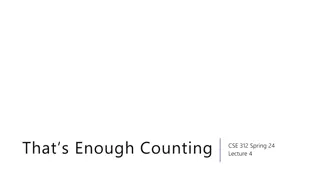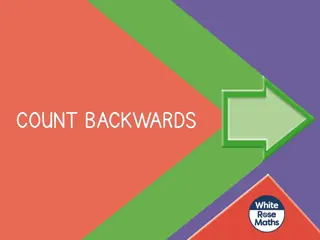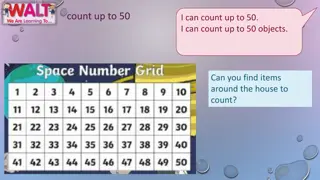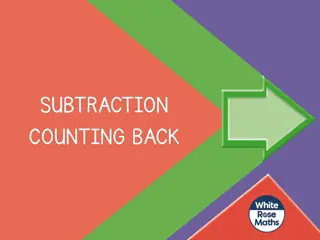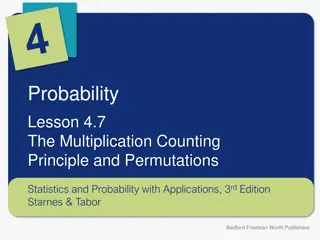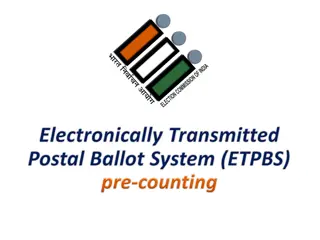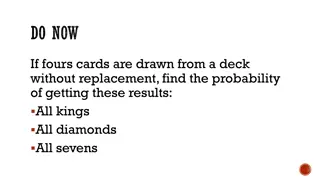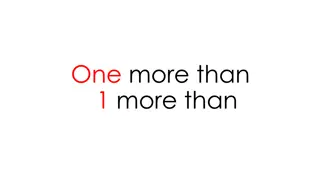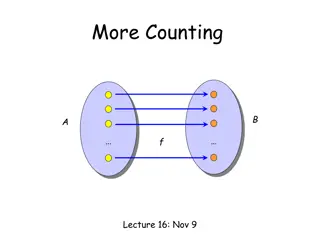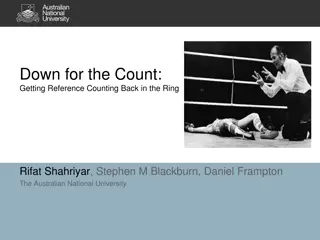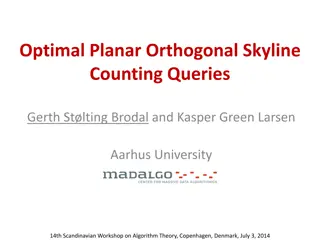Exploring Number Systems: Counting to Irrational Number
Our number system has evolved over time to include various types of numbers, starting from counting numbers like 1, 2, 3, to whole numbers including zero, and extending to integers, rational, and irrational numbers. Each category serves a unique purpose in mathematics, with rational numbers representing fractions and irrational numbers encompassing values that cannot be expressed as ratios of integers. By delving into the characteristics and significance of these different number types, we gain a deeper understanding of the richness and complexity of our numerical framework.
Download Presentation

Please find below an Image/Link to download the presentation.
The content on the website is provided AS IS for your information and personal use only. It may not be sold, licensed, or shared on other websites without obtaining consent from the author.If you encounter any issues during the download, it is possible that the publisher has removed the file from their server.
You are allowed to download the files provided on this website for personal or commercial use, subject to the condition that they are used lawfully. All files are the property of their respective owners.
The content on the website is provided AS IS for your information and personal use only. It may not be sold, licensed, or shared on other websites without obtaining consent from the author.
E N D
Presentation Transcript
Our Number System ID1050 Quantitative & Qualitative Reasoning
Counting Numbers Our system of expressing numbers has been purposefully constructed. We re going to explore the types of numbers used in that construction. The most basic need for a number system is to count. The first evidence of the use of notches for counting is forty thousand years old. Not all cultures keep track of all counting numbers. Australian aborigines have words only for one , two , and then many . What we term the counting numbers begins with 1 and sequentially adds one to the previous result, as many times as needed. The counting numbers, then, are 1, 2, 3, 4, 5, (the list is infinite, which means it continues as far as needed, without end). Counting Numbers 2 3 4 1
Whole Numbers Of course, we started counting from nothing, but we don t use zero to count anything. Never-the-less, the concept of zero or nothing is important in mathematics. Including zero with the counting numbers forms the set of whole numbers. Again, not all cultures have a mathematical need for zero . Our concept of zero was invented in India, and independently by the Mayans and others. Whole Numbers Counting Numbers 2 3 4 1 0
Integers You can t count below zero, but you can have numbers that represent direction. Including a negative sign in front of each counting number forms the set of integers. Integers can be used to indicate height above or below sea-level, or money earned or owed, for instance. There are an infinite number of negative numbers now included with our infinite set of positive numbers. Integers Whole Numbers Counting Numbers -4 -3 -2 2 3 4 -1 0 1
Rational Numbers We sometimes need to express values that are not whole parts, but fractional parts. We define the set of rational numbers as any number that can be expressed as the ratio of an integer over another integer (other than zero). There are an infinite number of rational numbers just between zero and one. Here are some of them: 1/2, 1/3, 1/4, 1/5, Here are more: 2/3, 13/16, 1001/4812, There is an infinite number of rational numbers between any two integers. The set of integers is included in the set of rational numbers. For instance, 4 can be expressed as the ratio 4/1, so it is rational. So is zero.
Irrational Numbers It seems like all the space between zero and one is filled with rational numbers, but it isn t. There is another infinite set of numbers between zero and one. These are called the irrational numbers. Irrational numbers are numbers that cannot be expressed as the ratio of two integers. Numbers that are square roots, cube roots, etc. are likely to be irrational. The radical symbol, , is often used to indicate a root Special numbers like are also irrational.
Rational or Irrational? Numbers are either rational or irrational. How do you tell which it is? A good way is to express the number in decimal form (using a calculator). If a number is rational, its decimal form will either have a set of digits that repeats forever (0.333 , or8.131313 , or -1.00 ) Or, its decimal form will truncate (0.5, or 4.125). If a number is irrational, its decimal form will have no set of digits that repeats (0.1121231234 , -0.1257911131517 , 3.14159265 ) Roots often indicate that a number is irrational ( 2, 3, 5 ) Check on the calculator, though. 4 = 2, which is rational because it truncates.
The Real Numbers Together, the set of rational and irrational numbers make up what we call the real numbers. This course will deal exclusively with the set of real numbers.
Summary Real Numbers Rational Numbers Integers Whole Numbers Counting Numbers -4 -3 2 3 4 -2 -1 0 1 Rational Numbers Rational Numbers , - , -1/3, - , , , 1/3, , ,0.001, 0.01, 0.1, Irrational Numbers , 0.1111111, 0.22222, , 2, 3, 5, 0.1121231234 , 0.1357911131517 , etc.



